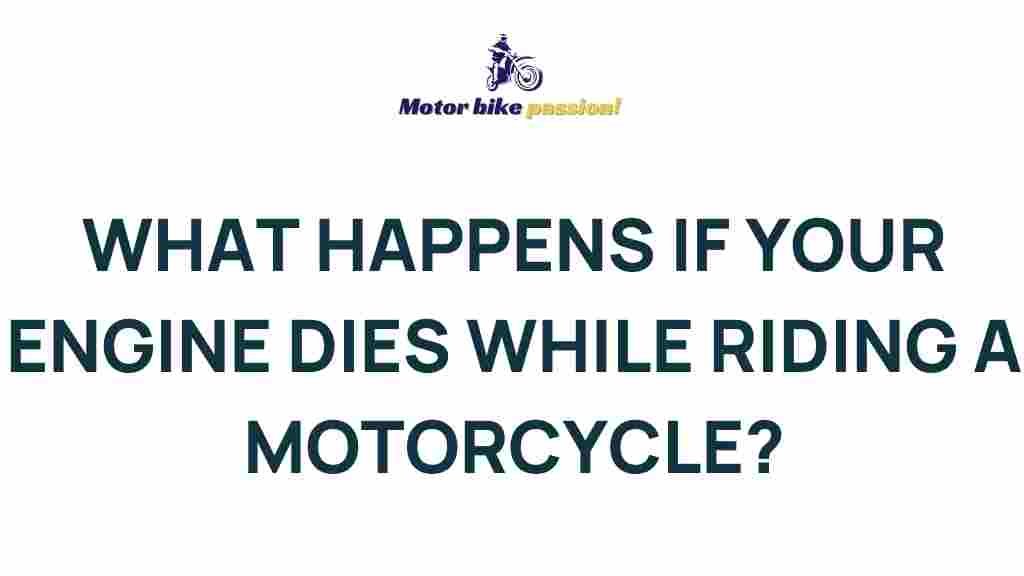The Silent Threat: What Really Happens When Your Engine Dies Mid-Ride
Motorcycling offers a unique sense of freedom and adventure, but it also comes with its risks. Among the most alarming situations a rider can face is engine failure while on the road. This silent threat can lead to dangerous circumstances and potentially disastrous outcomes. Understanding the implications of engine failure, knowing safety protocols, and being prepared with proper emergency procedures are vital for every motorcyclist. In this article, we will explore what happens during an engine failure, how to handle it safely, and the importance of maintenance and roadside assistance.
Understanding Engine Failure
Engine failure is when your motorcycle’s engine stops running unexpectedly. This can occur due to various reasons, including:
- Mechanical issues: Problems in the engine or transmission can lead to sudden failure.
- Fuel problems: Running out of gas or using contaminated fuel can cause the engine to quit.
- Electrical failures: Issues with the battery, ignition system, or wiring can lead to engine shutdown.
- Overheating: If the engine overheats, it can seize up and stop functioning.
Recognizing the signs of potential engine failure before it occurs can save lives and prevent accidents. Common indicators include unusual noises, warning lights on the dashboard, or changes in performance. Always pay attention to these cues.
What to Do When Your Engine Fails
Experiencing engine failure can be frightening, especially if it happens while riding at high speeds. Here’s a step-by-step guide on what to do:
Step 1: Stay Calm
The first and most important step is to remain calm. Panic can exacerbate the situation and lead to poor decision-making.
Step 2: Assess Your Surroundings
Once you have regained your composure, quickly assess your surroundings:
Step 3: Slow Down Gradually
Begin to slow down your motorcycle gradually. Avoid sudden braking, as this can lead to loss of control. Use your engine braking by downshifting to lower gears if possible.
Step 4: Signal Your Intentions
Use your turn signals to indicate to other drivers that you are having trouble. This can help prevent accidents and make others aware of your situation.
Step 5: Pull Over Safely
When you reach a safe location, pull over and stop the motorcycle. Ensure you are out of the way of traffic.
Emergency Procedures Following Engine Failure
After safely stopping, it’s essential to follow specific emergency procedures:
- Turn on Hazard Lights: Activate your hazard lights to alert other road users.
- Assess the Situation: Check for obvious issues, such as fuel leaks or electrical problems.
- Call for Help: If you cannot resolve the problem, call for roadside assistance. Having a reliable roadside assistance plan is crucial for all motorcyclists.
For more information on roadside assistance options and plans, check out this resource.
Common Troubleshooting Tips
While waiting for assistance, you can perform some basic troubleshooting to determine the issue:
- Check Fuel Level: Ensure you have enough fuel. If you ran out, you may need to walk to a nearby gas station.
- Inspect the Battery: Check for loose connections or corrosion on terminals.
- Look for Warning Lights: Take note of any warning lights that were illuminated before the failure.
- Examine Fuses: A blown fuse can cause electrical failures; check the fuse box if accessible.
These simple checks can sometimes help you identify the problem or prepare you for when help arrives.
The Importance of Motorcycle Maintenance
Preventing engine failure starts with proper motorcycle maintenance. Regular check-ups can help you identify potential issues before they become serious problems. Here are some essential maintenance tips:
- Regular Oil Changes: Change the oil according to the manufacturer’s recommendations to keep the engine lubricated.
- Inspect the Cooling System: Ensure that the coolant levels are adequate to prevent overheating.
- Check the Battery: Regularly inspect and maintain the battery and its connections.
- Brake Maintenance: Keep an eye on your brake pads and fluids for optimal stopping power.
- Tire Condition: Inspect tires for wear and maintain proper air pressure.
By adhering to a regular maintenance schedule, you can significantly reduce the chances of experiencing engine failure.
Motorcycle Safety: Staying Prepared
In addition to maintenance, being prepared for emergencies is essential for motorcycle safety. Here are some tips to help you stay prepared:
- Carry a Basic Tool Kit: Having tools handy can help you address minor issues on the road.
- Wear Protective Gear: Always wear a helmet, gloves, and protective clothing to minimize injuries in case of an accident.
- Take a Safety Course: Enroll in a motorcycle safety course to improve your riding skills and awareness.
- Know Emergency Procedures: Familiarize yourself with emergency procedures for various situations.
Being proactive about motorcycle safety can make all the difference during unexpected situations.
Conclusion
Engine failure is a silent threat that every motorcyclist should be aware of. By understanding the implications of an engine failure, following emergency procedures, and engaging in regular motorcycle maintenance, you can significantly enhance your safety on the road. Remember, preparation is key. Carry a roadside assistance plan, stay alert to your motorcycle’s performance, and maintain your bike to ensure a smooth ride. If you ever find yourself dealing with an engine failure, stay calm, follow the outlined steps, and reach out for help when needed. With the right knowledge and preparation, you can minimize the risks associated with this silent threat.
This article is in the category Safe Driving and created by MotorBikePassion Team

3 thoughts on “The Silent Threat: What Really Happens When Your Engine Dies Mid-Ride”